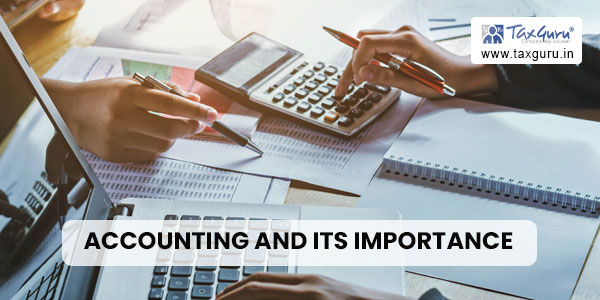Introduction: It is the process of 𝐫𝐞𝐜𝐨𝐫𝐝𝐢𝐧𝐠 𝐭𝐫𝐚𝐧𝐬𝐚𝐜𝐭𝐢𝐨𝐧𝐬 𝐚𝐧𝐝 𝐜𝐨𝐦𝐦𝐮𝐧𝐢𝐜𝐚𝐭𝐢𝐨𝐧 𝐨𝐟 𝐟𝐢𝐧𝐚𝐧𝐜𝐢𝐚𝐥 𝐢𝐧𝐟𝐨𝐫𝐦𝐚𝐭𝐢𝐨𝐧. The process of accounting starts by identifying the transactions having financial effects, and then 𝐝𝐢𝐯𝐢𝐝𝐞 𝐢𝐧𝐭𝐨 𝐭𝐰𝐨 𝐩𝐚𝐫𝐭𝐬 depending upon the effect and timing, First 𝐂𝐚𝐩𝐢𝐭𝐚𝐥 Nature and other 𝐑𝐞𝐯𝐞𝐧𝐮𝐞 Once the transaction is divided into parts then that will be further categorized into three parts for accounting 𝐑𝐞𝐚𝐥 𝐏𝐞𝐫𝐬𝐨𝐧𝐚𝐥 and 𝐍𝐨𝐦𝐢𝐧𝐚𝐥. Real and Personal Generally deals with Capital Nature of Incomes and Expenses and Nominal deals with Revenue Expenses. It is the act of Recording, Classifying and Summarising of Financial Transactions and Events and interpreting the results thereof.
Objectives:
1. Systematic recording of transactions i.e., Book Keeping
2. Analysis of results of above recorded transactions i.e., Profit & Loss; Balance Sheet Cash flow Statement etc.
3. Ascertainment of the Perpetual Succession, Solvency Position from financial positions of the business.
4. Providing information to the users for rational decision making i.e., Financial Reports
Page Contents
Users of Financial Information:
1. Management: Interested in knowing the financial position of the business.
2. Investors: New investors who are going to invest their money in an organisation wants to see the progress and prosperity of that organisation.
3. Lenders: As they are the lenders of finance to an organisation, always keeps an eye on the financial position of that organisation.
4. Suppliers: As they are the supplier of the goods and services, it is usual that they are interested to know the financial soundness before granting any credit.
5. Customers: As they are the end user of the product of an organisation, they are desperate to know the pricing and affordability of the products
6. Employees: Financial position and profitability of an organisation helps in making demand for hike in salary, bonus, improved working conditions etc.
7. Government: Keeps a close watch on the organisations for collecting taxes, which makes huge profits.
Types of Books of Accounts and Other Documents:
As per Sub rule (2) of Rule 6F the following books of accounts and other documents are required to be maintained as per Income Tax Act 1961.
- Cash Book
- Journal, if accounts are maintained on mercantile system.
- Ledgers
- Photo copies of bills and receipts issued by the assesses whether machine numbered or otherwise serially numbered for an amount exceeding Rs 25
- Original bills and receipts issued to the assessee for expenditure exceeding Rs 50
- Daily case register in form 3C (Only for Medical Professionals).
- Inventory register (Only for Medical Professionals).
- The books of accounts and other documents should be maintained at the principal place of business.
- The books of accounts and other documents shall be kept for at least 6 years from the end of the relevant assessment year.
Compulsory Maintenance of Books of Account for Tax Audit:
Sec 44AA provides that every assessee carrying on Business or Profession shall maintain such Books of Accounts and Other documents as may enable the assessing officer to compute the total income of the assessee in accordance with the provisions of Income Tax Act, 1961.
Applicability Limit:
- Business or Profession:
- If Income exceeds Rs 2,50,000 (or)
- Total turnover/gross receipts exceed Rs 25,00,000 in any one of 3 years immediately preceding the previous year
- Special Cases:
- If assesse declares lower income u/s 44AD & 44ADA and net total income is exceeding Rs 2,50,000
- If assesse declares lower income u/s 44AE, 44BB & 44BBB

Consequences of Non-Maintenance of Books of Accounts:
- As per section 271A, in case of failure to maintain the books of accounts shall attracts a penalty of Rs 25,000
- In case of an international transaction, failure to maintain information and documents for transactions would lead to a penalty of 2% of the value of that international transaction
Importance of Maintaining Books of Accounts:
1. 𝐇𝐞𝐥𝐩𝐬 𝐭𝐨 𝐮𝐧𝐝𝐞𝐫𝐬𝐭𝐚𝐧𝐝 𝐡𝐢𝐝𝐝𝐞𝐧 𝐜𝐨𝐬𝐭 for e.g. Generally, I had seen in case of most of the traders they transfer a sum of amount from Bank Account to DMAT, after trading the Broker Company provides the P&L Statement which is as per transaction, but other expenses missed which can be calculated with the help of proper Accounting)
2. 𝐇𝐞𝐥𝐩𝐬 𝐭𝐨 𝐏𝐥𝐚𝐧 𝐈𝐧𝐜𝐨𝐦𝐞/ 𝐑𝐞𝐜𝐞𝐢𝐩𝐭 for e.g., Suppose You are free-lancer and providing services to various clients Accounting will give you comparative study to more preferential Client and least priority one.
3. 𝐂𝐨𝐬𝐭 𝐀𝐧𝐚𝐥𝐲𝐬𝐢𝐬 𝐨𝐟 𝐁𝐮𝐬𝐢𝐧𝐞𝐬𝐬/𝐒𝐞𝐥𝐟, it helps to plan better on all the expenses cost cutting etc.
4. For a 𝐒𝐭𝐚𝐫𝐭-𝐮𝐩 𝐢𝐭 𝐰𝐢𝐥𝐥 𝐡𝐞𝐥𝐩 𝐭𝐨 𝐫𝐚𝐢𝐬𝐞 𝐟𝐮𝐧𝐝𝐬, we generally herd What is Gross Margin? What Operating Margin? What is net profit? These data only be found out from accounting.
5. It 𝐡𝐞𝐥𝐩𝐬 𝐭𝐨 𝐩𝐫𝐞𝐬𝐞𝐧𝐭 𝐛𝐞𝐭𝐭𝐞𝐫 𝐈𝐧𝐯𝐞𝐬𝐭𝐨𝐫, TCWG, CEO, CFO wants data in Ratios like P/E Ratio Debt-Equity Ratio and so on everything can be derived from accounting data.
6. It will 𝐡𝐞𝐥𝐩 𝐢𝐧 𝐜𝐨𝐦𝐩𝐥𝐢𝐚𝐧𝐜𝐞 like advance taxes TDS, work as evidence proof regarding any Taxation Legal notices.




